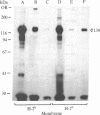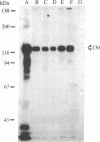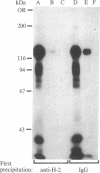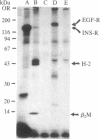Abstract
Molecular association between major histocompatibility complex (MHC) antigens and cellular proteins are thought to be involved in various immunological and nonimmunological functions of MHC antigens, including hormone signaling. The existence of physical interactions between insulin receptors and MHC class I antigens was investigated in liver plasma membranes from congenic H-2k mice. Insulin receptors were specifically labeled with a 125I-labeled photoreactive insulin analogue, and cellular proteins were solubilized and incubated with various monoclonal antibodies. Immunoprecipitates were analyzed by polyacrylamide gel electrophoresis followed by autoradiography. Antibodies reacting with distinct epitopes on H-2k class I antigens were all able to precipitate up to 25% of the labeled insulin receptors in H-2k mouse liver membranes, whereas no insulin receptors were precipitated in H-2b mouse liver membranes. Sequential immunoprecipitations showed that insulin receptors and H-2 antigens were coprecipitated and that no cross-reactivity occurred. The specificity of the interaction between insulin receptors and H-2 antigens was demonstrated after double labeling of membrane proteins by photoreactive insulin and lactoperoxidase-catalyzed iodination. These results thus show that, in mouse liver membranes, insulin receptors are physically associated to class I antigens of the MHC.
Full text
PDF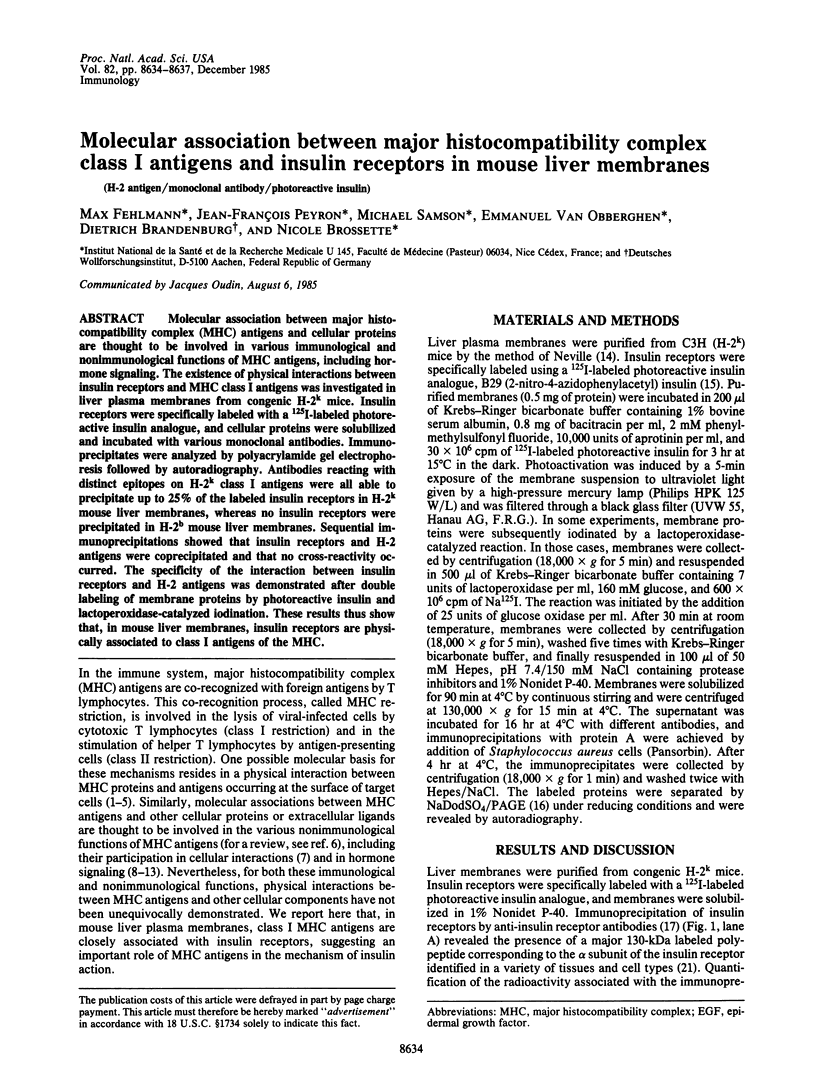
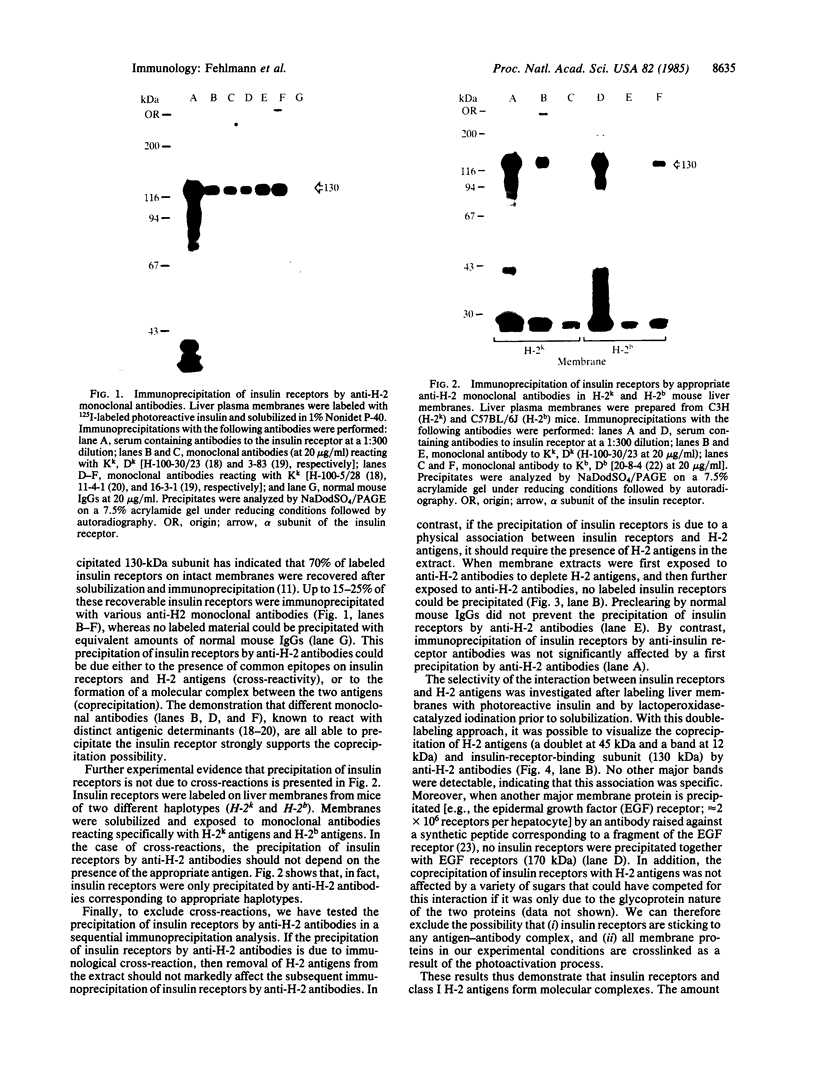
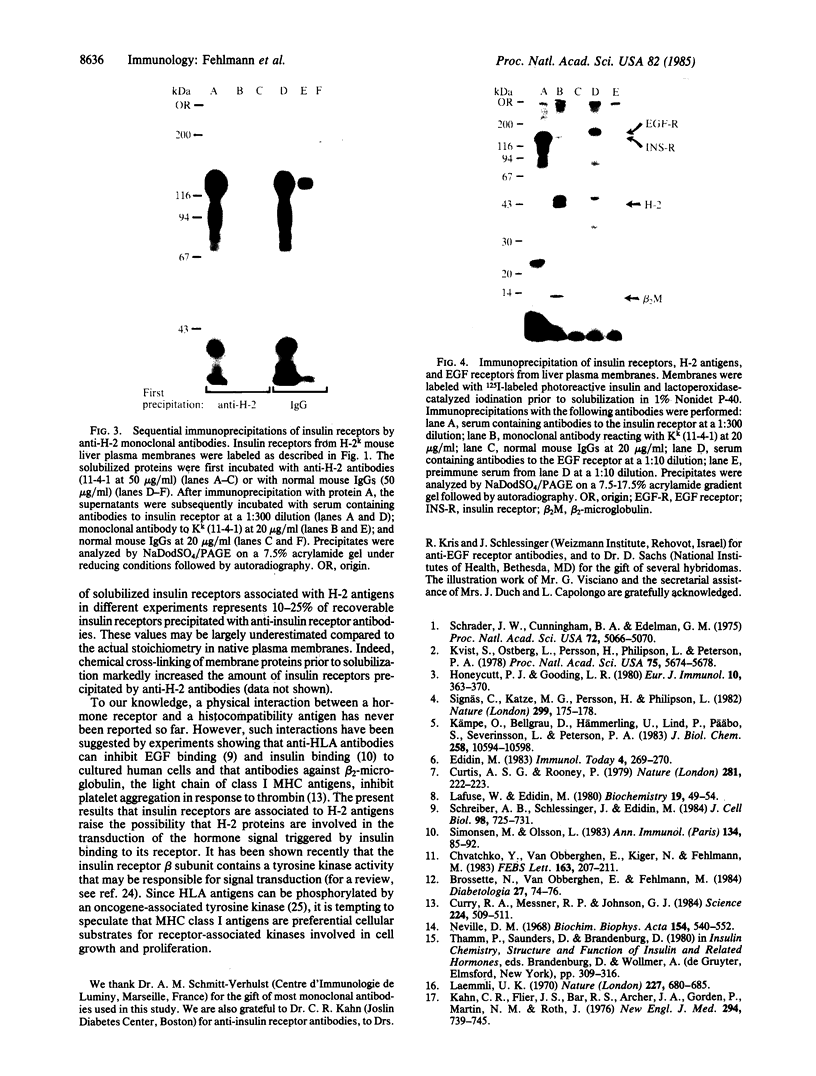
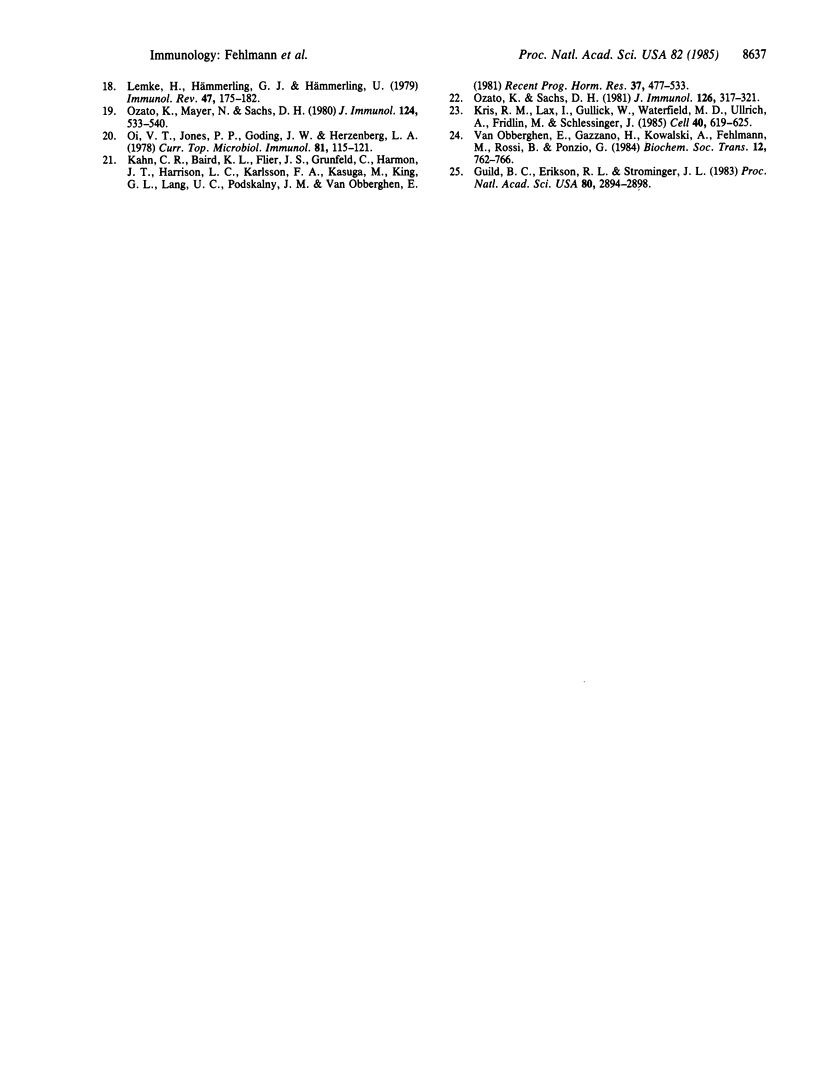
Images in this article
Selected References
These references are in PubMed. This may not be the complete list of references from this article.
- Brossette N., Van Obberghen E., Fehlmann M. Interaction between insulin receptors and major histocompatibility complex antigens in mouse liver membranes. Diabetologia. 1984 Jul;27 (Suppl):74–76. doi: 10.1007/BF00275651. [DOI] [PubMed] [Google Scholar]
- Chvatchko Y., Van Obberghen E., Kiger N., Fehlmann M. Immunoprecipitation of insulin receptors by antibodies against Class 1 antigens of the murine H-2 major histocompatibility complex. FEBS Lett. 1983 Nov 14;163(2):207–211. doi: 10.1016/0014-5793(83)80820-5. [DOI] [PubMed] [Google Scholar]
- Curry R. A., Messner R. P., Johnson G. J. Inhibition of platelet aggregation by monoclonal antibody reactive with beta 2-microglobulin chain of HLA complex. Science. 1984 May 4;224(4648):509–511. doi: 10.1126/science.6324346. [DOI] [PubMed] [Google Scholar]
- Curtis A. S., Rooney P. H-2 restriction of contact inhibition of epithelial cells. Nature. 1979 Sep 20;281(5728):222–223. doi: 10.1038/281222a0. [DOI] [PubMed] [Google Scholar]
- Guild B. C., Erikson R. L., Strominger J. L. HLA-A2 and HLA-B7 antigens are phosphorylated in vitro by rous sarcoma virus kinase (pp60v-src) at a tyrosine residue encoded in a highly conserved exon of the intracellular domain. Proc Natl Acad Sci U S A. 1983 May;80(10):2894–2898. doi: 10.1073/pnas.80.10.2894. [DOI] [PMC free article] [PubMed] [Google Scholar]
- Honeycutt P. J., Gooding L. R. Solubilization of complexes between tumor-associated and H-2 antigens from a tumor cell plasma membrane. Eur J Immunol. 1980 May;10(5):363–370. doi: 10.1002/eji.1830100509. [DOI] [PubMed] [Google Scholar]
- Kahn C. R., Flier J. S., Bar R. S., Archer J. A., Gorden P., Martin M. M., Roth J. The syndromes of insulin resistance and acanthosis nigricans. Insulin-receptor disorders in man. N Engl J Med. 1976 Apr 1;294(14):739–745. doi: 10.1056/NEJM197604012941401. [DOI] [PubMed] [Google Scholar]
- Kris R. M., Lax I., Gullick W., Waterfield M. D., Ullrich A., Fridkin M., Schlessinger J. Antibodies against a synthetic peptide as a probe for the kinase activity of the avian EGF receptor and v-erbB protein. Cell. 1985 Mar;40(3):619–625. doi: 10.1016/0092-8674(85)90210-7. [DOI] [PubMed] [Google Scholar]
- Kvist S., Ostberg L., Persson H., Philipson L., Peterson P. A. Molecular association between transplantation antigens and cell surface antigen in adenovirus-transformed cell line. Proc Natl Acad Sci U S A. 1978 Nov;75(11):5674–5678. doi: 10.1073/pnas.75.11.5674. [DOI] [PMC free article] [PubMed] [Google Scholar]
- Kämpe O., Bellgrau D., Hammerling U., Lind P., Päbo S., Severinsson L., Peterson P. A. Complex formation of class I transplantation antigens and a viral glycoprotein. J Biol Chem. 1983 Sep 10;258(17):10594–10598. [PubMed] [Google Scholar]
- Laemmli U. K. Cleavage of structural proteins during the assembly of the head of bacteriophage T4. Nature. 1970 Aug 15;227(5259):680–685. doi: 10.1038/227680a0. [DOI] [PubMed] [Google Scholar]
- Lafuse W., Edidin M. Influence of the mouse major histocompatibility complex, H-2, on liver adenylate cyclase activity and on glucagon binding to liver cell membranes. Biochemistry. 1980 Jan 8;19(1):49–54. doi: 10.1021/bi00542a008. [DOI] [PubMed] [Google Scholar]
- Lemke H., Hämmerling G. J., Hämmerling U. Fine specificity analysis with monoclonal antibodies of antigens controlled by the major histocompatibility complex and by the Qa/TL region in mice. Immunol Rev. 1979;47:175–206. doi: 10.1111/j.1600-065x.1979.tb00293.x. [DOI] [PubMed] [Google Scholar]
- Neville D. M., Jr Isolation of an organ specific protein antigen from cell-surface membrane of rat liver. Biochim Biophys Acta. 1968 Apr 9;154(3):540–552. doi: 10.1016/0005-2795(68)90014-7. [DOI] [PubMed] [Google Scholar]
- Oi V. T., Jones P. P., Goding J. W., Herzenberg L. A., Herzenberg L. A. Properties of monoclonal antibodies to mouse Ig allotypes, H-2, and Ia antigens. Curr Top Microbiol Immunol. 1978;81:115–120. doi: 10.1007/978-3-642-67448-8_18. [DOI] [PubMed] [Google Scholar]
- Ozato K., Mayer N., Sachs D. H. Hybridoma cell lines secreting monoclonal antibodies to mouse H-2 and Ia antigens. J Immunol. 1980 Feb;124(2):533–540. [PubMed] [Google Scholar]
- Ozato K., Sachs D. H. Monoclonal antibodies to mouse MHC antigens. III. Hybridoma antibodies reacting to antigens of the H-2b haplotype reveal genetic control of isotype expression. J Immunol. 1981 Jan;126(1):317–321. [PubMed] [Google Scholar]
- Schrader J. W., Cunningham B. A., Edelman G. M. Functional interactions of viral and histocompatibility antigens at tumor cell surfaces. Proc Natl Acad Sci U S A. 1975 Dec;72(12):5066–5070. doi: 10.1073/pnas.72.12.5066. [DOI] [PMC free article] [PubMed] [Google Scholar]
- Schreiber A. B., Schlessinger J., Edidin M. Interaction between major histocompatibility complex antigens and epidermal growth factor receptors on human cells. J Cell Biol. 1984 Feb;98(2):725–731. doi: 10.1083/jcb.98.2.725. [DOI] [PMC free article] [PubMed] [Google Scholar]
- Signäs C., Katze M. G., Persson H., Philipson L. An adenovirus glycoprotein binds heavy chains of class I transplantation antigens from man and mouse. Nature. 1982 Sep 9;299(5879):175–178. doi: 10.1038/299175a0. [DOI] [PubMed] [Google Scholar]
- Simonsen M., Olsson L. Possible roles of compound membrane receptors in the immune system. Ann Immunol (Paris) 1983 Jul-Aug;134D(1):85–92. doi: 10.1016/s0769-2625(83)80059-2. [DOI] [PubMed] [Google Scholar]
- Van Obberghen E., Gazzano H., Kowalski A., Fehlmann M., Rossi B., Ponzio G. The insulin receptor-kinase complex: an integrated system for transmembrane hormone signalling. Biochem Soc Trans. 1984 Oct;12(5):762–766. doi: 10.1042/bst0120762. [DOI] [PubMed] [Google Scholar]



